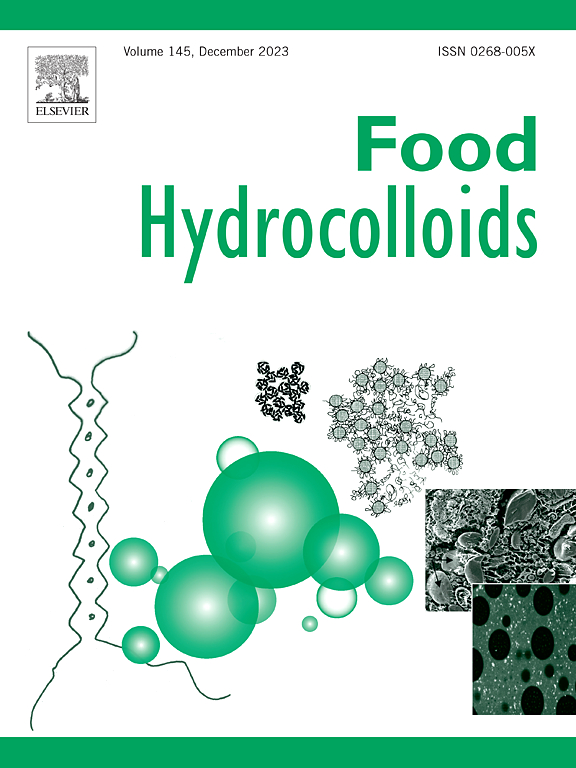Relating tribology to astringency perception in acidic plant protein-fortified fiber-based smoothies
IF 11
1区 农林科学
Q1 CHEMISTRY, APPLIED
引用次数: 0
Abstract
With increased need to address environmental sustainability, there has been a pronounced interest on incorporating plant proteins in health-promoting fiber-rich fruit based drinks. Often such matrices are acidic in nature posing challenges for incorporating plant proteins causing undesirable textural issues such as astringency, which is poorly understood in the literature. This study aimed to understand how tribological and rheological characterization can help to explain mouthfeel of plant proteins when incorporated in fiber-based matrices (both model and real smoothies) at pH 3.8. Ten different commercially available isolated plant proteins (5 wt% protein solutions) exhibited significant aggregation being close to their isoelectric point in the fiber-based model smoothie dispersion (0.3 wt% pectin, 0.8 wt% inulin). Particularly, the viscosity of model smoothies spanned across three orders of magnitude, with many, if not, most demonstrating shear-thinning behaviors. Plant proteins exhibited diverse frictional dissipation, with some of the tested commercial fava bean protein, pea protein and chickpea protein concentrates outperforming industry standards, such as soy protein isolate. Model smoothie's effectively mimicked real smoothies in mouthfeel attributes (11 trained panelists), showing plant proteins governing the mouthfeel. Pearson's correlation identified strong relationships between boundary friction, rheology, and sensory attributes, highlighting the predictive value of in vitro methods. Notably in legume proteins, %insoluble fraction negatively correlated with all tested undesirable attributes, such as astringency offering a facile screening metric for plant protein performance. Overall, this study validates the use of in vitro tools for mouthfeel assessment in complex food matrices, streamlining protein selection for accelerating the development of sustainable plant-based foods.

酸性植物蛋白强化纤维冰沙中摩擦学与涩味感知的关系
随着解决环境可持续性问题的需求日益增加,人们对在富含纤维的促进健康的水果饮料中加入植物蛋白产生了浓厚的兴趣。通常这类基质本质上是酸性的,这给植物蛋白的掺入带来了挑战,导致不希望出现的质地问题,如涩味,这在文献中知之甚少。本研究旨在了解摩擦学和流变性能如何帮助解释植物蛋白在pH值为3.8时加入纤维基质(模型和实际冰沙)时的口感。10种不同的市售分离植物蛋白(5 wt%蛋白质溶液)在纤维为基础的模型冰沙分散(0.3 wt%果胶,0.8 wt%菊粉)中表现出接近其等电点的显著聚集。特别是,模型平滑的粘度跨越了三个数量级,其中许多(如果不是的话)显示了剪切减薄行为。植物蛋白表现出不同的摩擦耗散,其中一些被测试的商业蚕豆蛋白、豌豆蛋白和鹰嘴豆蛋白浓缩物表现优于行业标准,如大豆分离蛋白。模型奶昔在口感属性上有效地模仿了真正的奶昔(11名训练有素的小组成员),显示了植物蛋白控制口感。皮尔逊相关性确定了边界摩擦、流变学和感官属性之间的密切关系,突出了体外方法的预测价值。值得注意的是,在豆类蛋白中,%不溶性分数与所有测试的不良属性负相关,如涩味,为植物蛋白性能提供了一个简单的筛选指标。总体而言,本研究验证了在复杂食物基质中使用体外工具进行口感评估,简化蛋白质选择以加速可持续植物性食品的开发。
本文章由计算机程序翻译,如有差异,请以英文原文为准。
求助全文
约1分钟内获得全文
求助全文
来源期刊

Food Hydrocolloids
工程技术-食品科技
CiteScore
19.90
自引率
14.00%
发文量
871
审稿时长
37 days
期刊介绍:
Food Hydrocolloids publishes original and innovative research focused on the characterization, functional properties, and applications of hydrocolloid materials used in food products. These hydrocolloids, defined as polysaccharides and proteins of commercial importance, are added to control aspects such as texture, stability, rheology, and sensory properties. The research's primary emphasis should be on the hydrocolloids themselves, with thorough descriptions of their source, nature, and physicochemical characteristics. Manuscripts are expected to clearly outline specific aims and objectives, include a fundamental discussion of research findings at the molecular level, and address the significance of the results. Studies on hydrocolloids in complex formulations should concentrate on their overall properties and mechanisms of action, while simple formulation development studies may not be considered for publication.
The main areas of interest are:
-Chemical and physicochemical characterisation
Thermal properties including glass transitions and conformational changes-
Rheological properties including viscosity, viscoelastic properties and gelation behaviour-
The influence on organoleptic properties-
Interfacial properties including stabilisation of dispersions, emulsions and foams-
Film forming properties with application to edible films and active packaging-
Encapsulation and controlled release of active compounds-
The influence on health including their role as dietary fibre-
Manipulation of hydrocolloid structure and functionality through chemical, biochemical and physical processes-
New hydrocolloids and hydrocolloid sources of commercial potential.
The Journal also publishes Review articles that provide an overview of the latest developments in topics of specific interest to researchers in this field of activity.
 求助内容:
求助内容: 应助结果提醒方式:
应助结果提醒方式:


